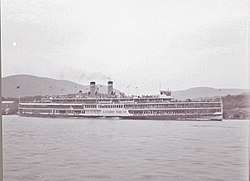PS Alexander Hamilton
Alexander Hamilton was a steamer built for the Hudson River Day Line[3] in 1924. It was added to the National Register of Historic Places on March 25, 1977. The remains of the vessel are located adjacent to the Naval Weapons Station Earle pier in Middletown Township, Monmouth County, New Jersey, United States.
 PS Alexander Hamilton on the Hudson River, 1933 | |
| History | |
|---|---|
| Name: | Alexander Hamilton |
| Owner: | Hudson River Day Line |
| Operator: |
|
| Route: | Hudson River between New York City and Albany, New York (until 1948) |
| Builder: | Bethlehem Shipbuilding Corporation |
| In service: | 1924 |
| Out of service: | 1971 |
| Fate: | Burned and sank 8 November 1977 |
| Notes: | Ruins still partially visible however wreckage is within the security region of Naval Weapons Station Earle |
| General characteristics | |
| Type: | Passenger steamboat |
| Length: | 349 ft 5 in (106.50 m)[1] |
| Beam: | 77 ft (23 m) |
| Draught: | 8 ft 4 in (2.54 m) |
| Draft: | 13 ft 6 in (4.11 m) |
| Decks: | 4 total, 3 complete and 1 partial |
| Installed power: | Four Scotch marine boilers |
| Propulsion: | Incline triple expansion engine |
| Capacity: | 3,000 |
 | |
| Location | near Naval Weapons Station Earle Middletown, New Jersey |
| Coordinates | 40°25′19″N 74°2′6″W |
| Built | 1924 |
| Architect | Bethlehem Shipbuilding Corporation |
| Demolished | November 8, 1977 |
| NRHP reference No. | 77000887[1] |
| NJRHP No. | 1960[2] |
| Significant dates | |
| Added to NRHP | March 25, 1977[1] |
| Designated NJRHP | October 22, 1976 |
History
The Hudson River Day Line used Alexander Hamilton to transport passengers along the Hudson River between New York City and Albany, New York.[4] In her later years, the run was shortened to a turnaround in Poughkeepsie. The steamer was built by the Bethlehem Shipbuilding Corporation in 1924.[5] The steamer operated from 1924 to 1971, first running with other Day Line Steamers, including the Peter Stuyvesant until the 1960s, when the company was purchased by the Circle Line, and became a one boat operation. She was over 300 feet in length and was built to handle more than 3,000 passengers. Her replacement was the passenger vessel Dayliner, which took over the run. Alexander Hamilton spent time at the South Street Seaport and Brooklyn Navy Yard before being moved to Atlantic Highlands, New Jersey. In 1977, the Alexander Hamilton was moved to a temporary berth along the east side of the Navy pier in Middletown Township. During a storm, she caught fire and sank next to the pier on November 8, 1977.
Design
The steamer's propulsion system consisted of four Scotch marine boilers delivering steam to an inclined triple expansion engine that turned a crankshaft attached to feathering paddle-wheels on the port and starboard sides. She was the last of the great Day Line "side-wheelers", and the last of her kind to ply the Hudson River.
See also
- National Register of Historic Places listings in Monmouth County, New Jersey
- PS Washington Irving - another Hudson River Day Line steamboat.
References
- "Alexander Hamilton". National Park Service. United States Department of Interior. Retrieved 28 April 2015.
- "New Jersey and National Registers of Historic Places" (PDF). NJ DEP - Historic Preservation Office. State of New Jersey. Archived from the original (PDF) on 6 February 2015. Retrieved 28 April 2015.
- https://www.newyorker.com/archive/1966/06/04/1966_06_04_029_TNY_CARDS_000284432 Accessed March 30, 2010.
- "Archived copy". Archived from the original on 2008-05-13. Retrieved 2010-03-30.CS1 maint: archived copy as title (link) Accessed March 30, 2010.
- "Sidewheels on the Hudson". Scuba Diving - New Jersey & Long Island New York. Retrieved 16 November 2010.
External links
![]()
- A YouTube video about the PS Alexander Hamilton